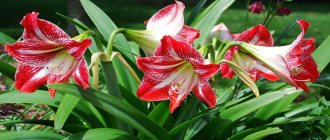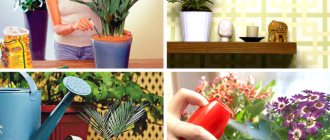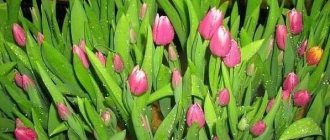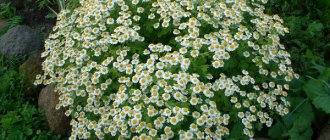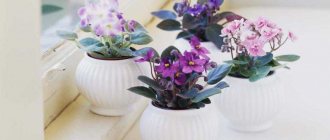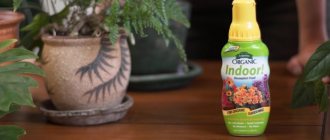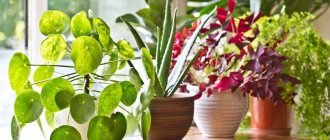The oleander plant (Nerium) is a member of the Kutrov family. According to data taken from various sources, this genus includes 3–10 species. The Latin name of such a culture comes from the Greek word “nerion”, which translates as “raw” or “wet”. The area in which the oleander grows must have groundwater located fairly close to the soil surface; at the same time, this crop is resistant to heat. In nature, it is found in subtropical regions of the Mediterranean. This flower is poisonous, but substances used to make medicines that are prescribed for disorders of the cardiovascular system are extracted from its leaves. If you inhale the scent of indoor oleander flowers for a very long time, this can cause headaches. Large flowers are pink, red, white or yellow. The most commonly grown species at home is the common oleander (Nerium oleander). Thanks to breeders, a large number of forms of such a plant with different flowers were born. If the bush is placed in a well-lit place, then in a short time it can reach a height of 200 cm.
Description
The homeland of oleander is the Mediterranean countries. It can also be found in Crimea and Transcaucasia.
The stems of the bush are covered with light gray or light brown bark.
The leaves are lanceolate, grow in whorls of 3, but can also be opposite. They are dark green on top and lighter at the bottom. Rare varieties are variegated.
The surface of the leaf plate and the edges are smooth, without roughness or notches. There is a pronounced vein running down the middle.
Flowering time is all summer and part of autumn. Buds appear only on young shoots.
The flowers are small, 3-5 cm in diameter. They are collected in inflorescences resembling a semi-umbrella and can be simple or double.
The oleander plant is poisonous: all its parts contain cardiac glycosides (oleandrin, cornerin, etc.).
Juice poisoning causes colic, vomiting and diarrhea. The substances included in its composition disrupt the functioning of the nervous system and cause cardiac arrest.
The aroma of the plant is quite pleasant, but can cause dizziness.
The oleander flower also has popular names:
- pink laurel;
- bad guy;
- down jacket;
- scarecrow;
- Leander
Description of oleander
The Kurtov family, to which oleander belongs, is very diverse. Most species contain poisonous milky sap, while others are used in cooking for preparing dishes. The common oleander flower belongs to the first type, so people with a sensitive nervous system are not recommended to grow it in an apartment.
Oleander or Nerium is valued for its decorative qualities during the flowering period. It continues from spring to autumn as the buds open one by one.
Due to the popularity of the plant in gardens, although oleander is a poisonous flower, breeders have been closely involved in it and have developed several new hybrid crops of pink, white, red and yellow flowers.
The average life expectancy is 15 years , but this period can be increased with timely care and rejuvenating procedures.
If you do not prune the oleander tree, it will grow up to 2 meters , that is, to the ceiling. This is not advisable, since the upper part of the crown will not receive light.
Growing in the wild
In the wild it is found in mountainous areas of the subtropics and tropics. Prefers highly moist soil, where groundwater comes close to the surface. There are varieties that can tolerate drought.
The Mediterranean, Caucasus, Crimea, Türkiye are the natural habitats of oleander. In northern latitudes and the middle zone, the crop can only be grown at home or in winter greenhouses.
Varieties with photos and names
Oleander is a monotypic genus. It contains only one species of the plant, Nerium oleander. All varieties of oleander grown at home originate from it thanks to the work of breeders.
White
There are two popular white oleander varieties: Casablanca and Mont Blanc. Both are considered quite unpretentious. But the second blooms much more abundantly and longer.
Casablanca on the left and Mont Blanc on the right
Other white varieties:
- Alba;
- Sister Agnes;
- Madonna Grandiflora
- Hardy white.
Pink
Pink oleander is the most common.
Variegated oleander on the left and the variety Emily Salute on the right
Varieties with this petal color include:
- Variegata - distinguished by variegated leaves;
- Rigoletto - has flowers with curled petals;
- Triumph - variety with pink-purple flowers;
- General Pershing - there is a white pattern on the pink petals;
- Furet - the petals have a pale pink color;
- Double Peach - double buds with light coral petals;
- Emilie Salut - gives the most abundant flowering of those listed;
- Martha Hanna Henslee - pink buds with dark veins;
- Roseum Plenum - characterized by large (up to 7 cm) flowers.
Most pink oleanders are characterized by double flowers. Simple flowers are produced by varieties such as Belle Helene and Hardy Pink.
Yellow and peach
Well-known varieties of yellow oleander are Maria Gambetta, Mathilde Ferrier and Luteum Plenum.
Sherrie Allen Turner, Angiolo Pucci and Mrs Roeding, Apricot Queen are painted in peach tones.
Reds
Red and burgundy oleanders are no less popular than pink ones.
The following varieties are known:
- Cardinal - deep burgundy, regular petals;
- Cerisa is an oleander with double flowers of bright crimson color;
- Hardy red - scarlet buds;
- Rubis - bright red double flowers;
- Algeria is a dark red oleander.
Other varieties of common oleander
Plants such as Fragrant Oleander and Indian Oleander are found in nature. They are also considered a subspecies of Nerium oleander. They are not cultivated at home.
A distinctive feature of Indian Oleander is its turquoise flowers. They can also be white, pink and red. Oleander Fragrant is a compact bush with double inflorescences.
Breeding rules
In indoor floriculture, propagation of decorative crops can be carried out in three ways:
- seed propagation is used quite rarely, as it involves the use of newly ripened seed material, soaked for half an hour in a solution of potassium permanganate, followed by washing under running water. Seeds should be germinated in a mixture based on equal parts of vermiculite, fine-grained sand and crushed charcoal. Surface sowing is done on a richly moistened substrate. Germination is carried out at temperatures within 32-34 ° C, and picking is carried out after the appearance of the fourth or fifth leaf;
- spring and autumn cuttings involve cutting shoots 10-12 cm long. The cut must be treated with dusty charcoal, after which the cuttings are placed in a planting mixture based on charcoal and fine-grained clean sand or perlite. Rooting requires good lighting, moderate humidity and temperature conditions at 22-24°C. It is allowed to root in water at room temperature with the addition of a small amount of coal;
- No less popular is propagation by air layering , which takes root in moistened sand or water. On the branches of the plant, you need to remove the bark in a circular manner, the width of which should be a couple of millimeters. After the roots appear on the cut, the young plant can be disconnected from the parent plant and replanted in flower pots.
Oleander: care at home
Caring for oleander at home is considered simple. The flower easily tolerates the summer heat and is not afraid of the bright sun.
But you will have to pay attention to the bush almost every day - in the summer it needs frequent watering.
Pot location and lighting
Oleander is a light-loving plant. The best place for it is the window sill of a south window. The leaves easily tolerate direct sunlight.
If the flower has already grown enough, it can be placed on the floor, but not far from the window. In winter, the pot should not be located close to the radiator.
On the northern, and often even on the western and eastern sides, the flower will lack light.
A sign of lack of light is faded leaves and small flowers.
If the problem is not eliminated, the shoots of the bush will stretch out and it will stop producing buds.
If it is not possible to provide the oleander with natural light, it needs to be supplemented with additional lighting. The lamps are not placed too close to the pot. The minimum distance is 70 cm.
It is better to place a pot of pink laurel in a spacious living room that can be frequently ventilated.
In a small bedroom, the aroma of a flowering bush can cause discomfort to the owner.
In summer, the pot can be placed on the balcony or terrace of the cottage.
If there are children or animals in the house, it is better to avoid growing oleander or place it in a place completely inaccessible to them.
You can be poisoned even by a small piece of oleander leaf.
Temperature
Temperature indicators that the owner of the oleander must take into account are given in the table.
| Period | Optimal temperature, °C | Limit temperature, °C |
| Summer | 24-28 | 32 |
| Winter | 12-15 | 5 |
Oleander can only withstand short-term frosts. Constant exposure to sub-zero temperatures will destroy the flower.
With the onset of the dormant period, you need to gradually prepare the plant for a cool winter. To do this, the temperature is reduced daily by 1-2°C.
If you immediately move the pot from the room to a cold room, the bush will freeze.
In the same way, they gradually increase the temperature in the spring and accustom the plant to the bright light of the sun.
Care at home and outdoors
The flower takes root well in greenhouses and winter gardens, but in apartment conditions, oleander requires especially careful and careful care.
ATTENTION!
The capricious oleander requires cool temperatures in winter and loves plenty of light.
How to care for your home oleander?
During care, it is advisable to strictly follow all the rules and regulations so that the fastidious plant grows healthy and delights with its lush flowering.
Can I keep it at home?
You can grow oleander at home, but it is recommended to maintain the required temperature - cool in winter and warm in summer , as well as give the plant a lot of light. Trimming the crown allows you to adapt the flower to the size of your home.
Lighting
Provide the plant with a bright place where it will receive plenty of sunlight and fresh air. Windows located on the south side are best suited. On the north side it is necessary to use additional light sources.
In winter, oleander also requires bright light. Place lamps at a distance of up to 0.7 m from the pot.
Transfer
A planned oleander transplant is carried out in mid-April. In the first 4 years of a flower’s life, its pot is changed annually.
For an older plant - once every 2-4 years, when the roots entwine the entire earthen ball. For an overgrown tree, it is enough to renew the top layer of soil mixture in the container.
Signs that a flower needs replanting:
- roots are visible from the drainage hole;
- the soil has become too dense and cannot be loosened;
- A white coating appeared on the soil surface.
Pot
For young seedlings, take containers with a diameter of 7-9 cm.
When replanting, the new oleander pot should be 2-3 cm larger than the previous one.
The plant produces buds only if the roots have mastered the earthen ball available to them. Therefore, having transplanted the bush into a container that is too large, you can allow it to bloom.
But if the pot is too tight and the root becomes deformed, this will lead to slower growth.
My oleander has already grown quite large. During replanting, I shorten the roots and return the tree to the same pot so that it does not grow even larger. Anna Sviridova, Ryazan, 10 years of experience in growing oleander.
Be sure to have drainage holes. And the pot for an adult specimen should be quite stable. Overgrown trees are planted in tubs.
The soil
The main requirement is that the soil for planting oleander must be loose and breathable.
Ready-made formulations designed specifically for oleander are not sold in flower shops.
You can use palm soil or any peat mixture that is suitable for acidity.
Recommended soil pH is 7-8.
A simpler option for preparing the soil yourself is turf soil, humus and peat, taken in equal proportions.
Sequencing
Step-by-step instructions for transplanting oleander:
- Water the plant generously so that the earthen lump is easily separated from the walls of the old pot.
- Place a layer of drainage (expanded clay, pebbles) on the bottom of the new container up to ¼ of the height of the pot, cover it with soil.
- Remove the bush from the old pot and inspect the roots.
- If damaged areas are found, cut them off and disinfect the “wounds” with crushed coal. If the roots are healthy, do not destroy the earthen ball.
- Place the flower in the center of the new pot, fill the free space with soil.
- Water the oleander and place it in a shaded place for several days.
You can see how oleander is transplanted in the video below.
Brief description of cultivation
- Bloom . In June–October.
- Illumination . Needs bright sunlight.
- Temperature regime . In spring and summer - from 20 to 28 degrees, in autumn - about 18 degrees, and in winter - 8-18 degrees.
- Watering . In spring and summer, watering is carried out immediately after the top layer of the substrate has dried, and in extreme heat the water remaining in the pan after watering is not poured out. In the autumn-winter period, you can wait until the soil mixture dries to a greater depth.
- Air humidity . Should be moderate. However, in the hot season, it is recommended to place the flower pot on a tray filled with moistened expanded clay.
- Fertilizer . In spring and summer, the bush is fed 2 to 4 times a month; for this purpose, mineral fertilizer for flowering plants is used. Fertilizing is carried out after 30 minutes. after watering.
- Rest period . From November to the last days of February.
- Trimming . Immediately after the bush fades.
- Transplant . In the last weeks of spring. Young bushes are replanted once a year, and adult specimens - once every 2 or 3 years. If the bush is very large, then every year in spring it will need to change the top layer of soil mixture in the container.
- Soil mixture . Peat, sand, humus, turf and leaf soil (1:1:1:2:1).
- Reproduction . Seed method and cuttings.
- Harmful insects . Mealybugs, scale insects, spider mites and aphids.
- Diseases . If the bush is not properly cared for or provided with inappropriate conditions, this can have an extremely negative impact on its decorative properties.
- Properties . This plant is poisonous, but medicines for heart diseases are made from its leaf blades.
Oleander. Reproduction, planting, care features
Oleander propagation
The method of propagation of oleander depends on the time of year. When choosing, you also need to consider how quickly you want to get flowering.
Air layering
This method is used in the summer, when the oleander does not need pruning. Only young shoots are taken as layering.
Step-by-step instructions on how to propagate oleander by layering:
- On the selected branch, cut off the bark in a circular manner. The distance from the cut to the end of the shoot is 10-15 cm. The thickness of the “ring” is 2-3 cm.
- Wrap the cut area with moss or place it in a bag of sand.
- Moisten moss or sand regularly.
- When sufficiently strong roots have formed, cut off the top.
- Plant a new specimen in a pot.
- Sprinkle the cutting area on the mother plant with charcoal.
The first roots will appear in about a month, and the seedling can be separated after 2-3 months from the start of the procedure.
The advantage of this method is the fastest appearance of buds in a young oleander.
By cuttings
To obtain a new oleander, shoots removed during pruning are used or a shoot is selected whose disappearance will not spoil the appearance of the bush.
As a cutting, take a young branch about 15 cm long. It should have a growing point and several leaves.
Step-by-step instructions for rooting an oleander cutting in a substrate:
- Treat the cut - dip in water and Kornevin powder.
- Place in a damp mixture of peat and sand. Deepen approximately 1 cm.
- Cover the container with film. Keep the improvised greenhouse in a bright place at a temperature of 20-22°C and ventilate regularly.
- After 1-1.5 months, plant the established specimens in the soil for an adult plant.
Oleander cuttings are also rooted in water. They are placed in warm, settled water no deeper than 1.5 cm. The leaves do not need to be torn off.
Liquid is added as needed. You can add activated carbon and root.
The cuttings are planted in the pot when the roots grow to 3-5 cm.
The first pruning of a young specimen is carried out after about six months.
You can see how oleander is cut by watching the video.
Seeds
Propagating oleander by seeds is not the most popular method. The reason for this is their low germination rate. In addition, it will take several years to wait for flowering with this method.
Step-by-step instructions for growing oleander from seeds at home:
- Treat the seeds with Epin or another growth stimulant.
- Place a wet mixture of sand and soil on the bottom of the container.
- Spread the seeds on the surface of the substrate. Don't bury it.
- Cover the container with film or a transparent lid.
- Keep in a bright place at a temperature of 30-35°C, regularly ventilate and moisten.
- When shoots appear, remove the film. Transfer the container to a cooler place (20°C).
- Plant young oleander specimens when they have 3-4 leaves.
Dividing the bush
The method is only suitable for large bushes with a well-developed root system.
The procedure is performed at the time of transplantation. The roots are cleared of soil and the bush is cut into pieces with a clean knife or pruning shears.
The cut areas are sprinkled with charcoal and dried. Each specimen is planted in a separate, smaller pot than before.
Features of oleander
A pot with an oleander bush should not be kept in a house where there are children or pets. All parts of this plant contain strong poison. Due to its high toxicity, it is advisable to carry out all work with the flower, including simply moving the pot, with gloves, and then wash your hands thoroughly. In addition, you should not place a bush in the bedroom - the sweet smell of the flowers of this plant can sometimes cause a headache. At the same time, different varieties of oleander can have a smell of varying intensity - from light and pleasant to strong and rich. That is why you should select varieties with a more subtle and unobtrusive aroma for your home.
The main reason for growing oleander is the high decorative value of the bush. The appearance of a flowering plant helps overcome autumn depression caused by lack of sun. Bright flowering shrubs are also used by landscape designers. In addition to its attractiveness, oleander is able to purify the air by releasing phytoncides. Its essential oils are even used in perfumery.
Oleander. Reproduction, planting, care features
Frequent care errors and their consequences
The loss of decorativeness by a flower is a direct consequence of mistakes made in caring for the oleander.
Botanist's opinion
An exception may be the fall of leaves - once every 3-4 years, adult oleanders renew their crown.
The table shows the most common problems and their probable causes.
| Flower problem | Provoking factor |
| The leaves are turning yellow | Overwatering the plant Unsuitable fertilizers |
| The tips of the leaves dry out | Insufficient watering Low humidity |
| The lower leaves are falling | Lack of light |
| The bush sheds leaves all over its height | Hypothermia Draft |
| The flower sheds its buds | Hypothermia Watering with cold water |
| Leaves and shoots have become lethargic | Root rotting due to overwatering |
Violation of the rules for caring for oleander can lead to the development of infections.
Care
Watering
In spring and summer, as soon as the top layer of soil in a flowerpot with oleander becomes dry, water it abundantly. During very hot periods, water can be poured into the tray and drained on cloudy and cool days. Instead of water, you can put wet pebbles or expanded clay in the pan. For irrigation use only warm water. If the plant is indoors, the water temperature should be 2-3 degrees higher than the room temperature.
Top dressing
Fertilizer "Rainbow" is perfect for feeding oleander
During periods of intensive growth (April-August), fertilizers for indoor plants are used to feed the plant. Such fertilizers as: “ Rainbow ”, “ Ideal ”, “ Giant ” are suitable.
You can fertilize oleander with diluted mullein. Fertilizing is carried out every 14 days on cool or cloudy days. The plant should be watered half an hour before fertilizing.
Mulching of oleander is carried out in spring and autumn. This allows you to protect the plant’s bark system, retain enough moisture, and also avoid overcooling of the roots. It is best to use mowed grass or sawdust as mulch and cover it with a layer of 5 cm.
Trimming
Flowers are cut off as they die, and after the flowering period, the tips of the stems are cut off. This stimulates branching. You should not prune in late autumn so that the plant does not become weak before frost.
Intensive pruning is carried out in the spring. In this period:
- remove old, intertwined and overgrown wood;
- remove the lower shoots of the plant to increase its flowering;
- cut off unnecessary shoots just above the nodes on the stems.
Trimming an oleander by more than 1/3 can severely weaken the plant, so it is important not to overdo it.
Oleander care in winter
In winter, the oleander needs to be provided with maximum lighting by using fluorescent lamps. They are placed above the plant at a level of 60-70 cm, the duration of illumination is 6-8 hours.
The place for wintering the oleander should be cool (8°C), and provided with an influx of fresh air, but without drafts. From about the second half of March, it is advisable to maintain the temperature at 15°C.
Diseases and pests
Powdery mildew most often affects oleander. The leaves of the bush are covered with a whitish coating.
These white spots are easily erased, but quickly reappear. If the flower is not treated, they acquire a brown tint.
Fungicides, such as Strobi or Quadris, are suitable for control.
Oleander also suffers from other diseases:
- botrytis appears as a gray powdery coating on the foliage;
- cercospora blight causes dark specks on the petioles and leaves of the plant;
- anthracosis causes spots on the foliage; at the beginning of the disease they are light with dark edges, then they darken and merge;
- aspergillosis leads to the appearance of a black coating, and over time, to the death of leaves;
- In the first days, rust appears as yellow spots; over time, they acquire a characteristic brown tint.
In addition to common diseases of indoor plants, pink laurel is characterized by infection with Pseudomonas savastanoi pv. nerii.
A sign of infection of an indoor flower with oleander cancer is dark growths on all parts of the plant.
Affected shoots must be removed immediately before the disease spreads. There is no cure for it. Prevention - pruning the flower only with a clean tool.
Oleander pests are listed in the table.
| Insect | Signs of infection |
| Spider mite | Whitish dots appear on the leaves, and as they develop, spider webs |
| Mealybug | Plaque that looks like pieces of cotton wool |
| Shields | Dark bumps and sticky coating on leaves |
| Aphid | Insects are visible to the naked eye Leaves curl and become deformed |
When damaged by pests, the flower is bathed in the shower with laundry soap. In the case of scale insects, it is more effective to collect it with a cotton pad soaked in alcohol.
After mechanical removal of insects, the bush is sprayed with insecticides. Actellik is suitable in almost any case.
From the video below you can learn about traditional methods of pest control.
Characteristics of common oleander and species diversity with names
Oleander is a bush with evergreen foliage and fragrant flowers, growing both in streets, gardens and in homes. The natural habitat of the plant is countries with a subtropical climate. Beautifully flowering thickets can be found on the shores of reservoirs in Europe, China, and North Africa, since it needs a lot of moisture.
The following characteristic features of oleander can be distinguished:
- height, depending on the variety, is 1.5-3 meters;
- leaf color – dark green;
- branching stems of a brown hue;
- narrow leaves up to 3 cm wide are attached to the stem by short roots;
- foliage length is 10-15 cm;
- flowers are large, five-petaled;
- the inflorescence is collected in a brush;
- colors: white, pink, red, yellow;
- specific pronounced aroma during flowering.
In the climatic conditions of our country, the bush can be grown in the house so that it pleases with greenery all year round, and in the summer it blooms with bright colors. The best cultivated plant for growing indoors is the common oleander, which comes in various varieties.
Features of the plant varieties presented in the photo are as follows:
- Rigoletto has double flowers of a pink hue, with curled petals in the center of the flower;
Rigoletto - Petite Salmon is a dwarf plant with small peach-colored flowers;
Petite Salmon - Mont Blanc is a profusely flowering bush with white and round flowers;
Mont Blanc - Cardinal has a fruity aroma, shades of flowers - raspberry, burgundy;
Cardinal - Hardyred with deep red petals, slightly terry texture;
Hardyred - Soleil Levant has pink flowers with yellow centers and a persistent scent;
Soleil Levant - Variegata is characterized by the presence of terry, narrow, elongated petals and a rich pink hue;
Variegata - Elegance has large flowers in shades from pink to peach, very fragrant.
Elegance
Oleander is well suited for growing in gardens and on open terraces and balconies, although the presence of such greenery in the house can also decorate it at any time of the year.
FAQ
What to do if the oleander does not bloom
The most common reason for the lack of buds is failure to trim. A lack of light can also lead to this situation. A sick, frozen plant will not bloom. If there are no buds, the gardener needs to analyze how he cares for the oleander, find and correct his mistake. In this case, it is impossible to give an unambiguous recommendation. “Stress” to stimulate flowering is not suitable for oleanders.
Why do oleander leaves turn faded?
This situation indicates a lack of light. Leaves lose color due to disruption of the photosynthesis process.
What to do if the oleander drops its leaves
If the bush begins to lose leaves, it needs to be moved to a warmer room. When ventilating the room, take the flower out of it. You also need to make sure that the plant is watered deeply enough and has enough light. If these factors are the problem, the leaves usually dry out first and then fall off.
What to do when the oleander has faded
When flowering ends, you need to remove the faded buds, carry out formative pruning and begin to prepare the bush for a cool winter, gradually lowering its temperature.
What are the beneficial properties of the flower?
Glycosides contained in the plant are used in pharmacology. Tinctures and lotions from the leaves of the plant are also used in folk medicine. Oleander leaves secrete phytoncides that cleanse the air of bacteria.
How to choose an oleander
First of all, pay attention to the condition of the leaves. They should be clean and shiny. If they have black dots on them, you should refuse to purchase. The condition of the soil is also important; there should be no signs of waterlogging.
Medicinal properties of oleander
Although oleander is considered a poisonous plant, it can be used for medicinal purposes. Its foliage contains valuable glycosides that can help treat certain heart diseases. Infusions of the leaves are used in folk medicine as a remedy for migraines, nervous exhaustion, insomnia and heart rhythm disorders. Oleander also helps veterinarians: products based on it are used to treat stomach or heart diseases in animals. But under no circumstances should you self-medicate.
Oleander flower. Description, features, types and care of oleander
Flower of Hiroshima. Oleander is called . It was the first to bloom in the lands affected by the atomic bomb. The Americans dropped the so-called “Baby” on the Japanese city in 1945.
The lands are empty. In this desolation, Oleander seemed like a miracle. Let's find out what gave the plant the strength to overcome radiation and whether it is possible to keep the flower at home.
Description and features of Oleander
Oleander is a flower from the Kurtov family. In shape, the hero of the article is an evergreen shrub. In nature, the common oleander stretches up to 4 meters. In home apartments the bush does not exceed 2, and often not even a meter.
The photo shows a common oleander
However, keeping Oleander at home is risky, especially when children and pets live indoors. The plant is poisonous, from roots to seeds. Knowledge is important, because poisoning with Oleander juices leads to convulsions, diarrhea, dizziness, even cardiac arrest.
All this was felt by the soldiers of the army of Alexander the Great. When conquering Crimea, they used the Oleander plant as sticks for frying meat over a fire. The juices of the flower soaked the food, making it poisonous too.
It becomes clear why the hero of the article populated the lands after a nuclear disaster. Oleander itself is a poison and is immune to unfavorable environmental conditions. At the same time, the appearance of the bush casts doubts.
Can such beauty carry mortal danger? And what a pleasant smell... Let us remember the lines of Sergei Yesenin: “Cold gold of the moon, The smell of Oleander and Levkoy. It’s good to wander among peace.”
Blooming Oleander truly pacifies with its aroma. Perfume lovers will remember Fendi Life and Rodier. In this perfume, Oleander is the main note. The smell of the flower will also come to mind for those who visited Crimea in the spring or summer. The bush blooms buds in mid-April. Oleander blooms only in October.
The photo shows a blooming double oleander
In the photo, Oleander stands out with its wheel-shaped flowers. They are wide open and pink, red, yellow or white in color. Some varieties have several rows of petals. This gives the buds a similarity to Roses and Peonies. The diameter of the buds does not exceed 5 centimeters.
But the number of flowers on the bush is large. The latter has a spreading form and gray, smooth trunks. They look like twigs, covered with elongated, lanceolate, dense greenery.
Oleander leaves are opposite. This means that the plates on the trunk are set opposite each other. Another feature of Oleander greens is the presence of smell. The aroma is weaker than that of flowers, but it is there. Yesenin, by the way, did not write about peace in vain.
Oleander extract is used to make ointments and creams for dermatitis and scabies. However, the poet meant peace of mind. Not everyone enjoys the scent of the hero of the article. The smell is so strong that it makes some people dizzy.
Therefore, growing Oleander is recommended in gardens and spacious rooms for active pastime. In a small bedroom, for example, a flower can have a depressing smell and cause insomnia.
The photo shows an oleander in the open ground
Oleander fruits ripen by November. The box contains parachute seeds. They contain a medicinal component, due to which the hero of the article is included in a number of medicines. When drying, the Oleander fruit cracks and the grains scatter around the circumference.
If you collect the seeds and store them until spring, they will lose their viability. It is also uneven in the case of fresh grains. So, Oleander is sown immediately after the fruits ripen. However, we’ll talk about plant propagation separately.
Reproduction and planting of Oleander
Due to the complexity of working with the seeds of the hero of the article, it is customary to disconnect the stalk from it. from Oleander in the off-season. A 15cm cut is required. It must have at least 4 buds.
In the photo there is an indoor oleander
A cut of an Oleander cutting is sprinkled with crushed coal. It disinfects and dries the “wound,” eliminating infection and decay. You can place the cuttings in a substrate of sand, turf soil and humus. The components are taken in equal proportions.
You can also root a bush cutting in a mixture of sand and charcoal. However, the substrate is not suitable as a permanent soil. When transplanting to a permanent place, the soil will have to be changed.
To root Oleander at home, you will need a temperature of 21 degrees. The cutting takes root in it in about a month. When the branch grows to 4-5 leaves, it is transplanted to a permanent place.
When manipulating Oleander, it is important to work with gloves, avoiding contact of plant juices with the skin and mucous membranes. Precautionary measures are needed whenever touching a flower.
It’s better to just breathe the air they provide. It has been proven that the hero of the article produces phytoncides. These compounds kill fungi and pathogenic bacteria in the atmosphere. So, living next to Oleander is dangerous and useful at the same time.
To propagate the bush, it is customary to take last year’s branches. Buds are formed only on young shoots. Accordingly, it is not a pity to remove old shoots. In addition, Oleander still requires pruning to shape the bush. She can be anyone. The flower survives pruning with ease.
Oleander Care
Buying Oleander for a dark home is a losing option. The hero of the article is made from rare plants that love direct rays of the sun. Even the reproduction of Oleander will not work without bright light.
The photo shows a pink oleander
And in adulthood, the bush will begin to wither, stretch out and refuse to bloom. In winter, the hero of the article will also shed leaves. Therefore, it is necessary to highlight indoor Oleander , stretching the day to at least 10 hours.
In addition to light, the plant loves fresh air. When growing a bush in the house, you will have to constantly open the windows, or take the Oleander out to the balcony or loggia. Temperature regime of Oleander: - 15 degrees in winter and up to 27 in summer. The transition from minimum to maximum should be smooth. Sudden temperature changes weaken the plant's immunity.
The hero of the article is not picky about spraying. The exception is the heating season. Batteries dry out the air. As a result, the ends of the Oleander leaves may dry out. To avoid this, the bush is kept away from heating devices and irrigated 1-2 times a day.
Oleander's watering regime is constant. Give the flower a drink every 3-4 days. You need to make sure that the water is soft, settled, and slightly warm. The soil has time to dry out slightly between waterings. If the soil is acidic, the risk of Oleander root rot increases. Caring for it requires soil with a neutral or slightly alkaline pH.
After watering, the hero of the article is fed. Fertilizers are given during the period of active growth once every 2 weeks. Mineral complexes are suitable. Organic fertilizers harm Oleander, inhibiting flowering and causing excessive growth of green mass.
It is advisable to give fertilizer to Oleander in the evenings. The watering regime is adjusted accordingly. Oleander is especially good for watering after transplantation. It is carried out as needed. The reference point is the entwining of roots around a clod of earth in a pot. In the garden, plants can remain in one place.
The photo shows a yellow oleander
The easiest way for the hero of the article to survive the transplant is at the end of spring. During this period, the bush is full of strength and energy, there is something to spend on establishing itself in a new place. So that all the energy is not wasted on this, Oleandra’s roots are partially cut off, treating the “wounds” with charcoal.
Shortened roots require fewer resources. Due to this, the plant begins to bloom wildly. What the buds will be like depends on the Oleander variety. Why isn't there a conversation about species? It will become clear from the next chapter.
Types and varieties of Oleander
Oleander is part of the genus of the same name in the Kurtov family. The genus belongs to the “mono” group, that is, it consists of one species. This is Oleander "Common". All known varieties belong to it.
"White" Oleander in offices . It has 5 petals, bent to one side, like a Dream Gate. The color of the buds, as is clear from the name of the variety, is white.
The plant is unpretentious and therefore ideal for public places. The main thing is that these are not kindergartens, animal nurseries and other organizations in which not everyone is aware of the danger of Oleander.
Oleander “Yellow” is also named after the color of its buds. Its flowers are like bells and have the same funnel at the base. The variety and racemose inflorescences are distinguished. The buds in them are collected in groups.
In the photo there is a white oleander
There are yellow flowers, and there are also soft peach ones. You can admire them from early summer to November. This is in warm regions. Oleander feels especially at ease in the Black Sea region and the Caucasus.
“Pink-double” varieties of Oleander have several circles of petals. The buds, similar to Peonies, are covered with fibers and are velvety. The foliage also stands out. It is deliberately oblong and thin, like Willow's.
Variegated varieties of the hero of the article have also been bred. Example: - “Star of Persia”. The buds have a golden center and peach edges. If you want a combination of white and crimson, you should pay attention to Scarlett.
The “Ordinary” Oleander is conventionally divided into 2 subspecies: “Indian” and “Fragrant”. The latter varieties have a particularly strong aroma. Because of this, the plant is rarely kept at home. The smell is sweet. But in terms of size, the “Fragrant” varieties are ideal for apartment living; they do not exceed 50 centimeters.
Indian Oleander , on the contrary, is the largest. The bushes reach 4 meters, decreasing slightly at home. True, you can control the growth of Oleander by pruning and shaping the crown.
In the photo there is an oleander tree
But you can’t make a 1-in meter out of 4. You need to tune in to 2-2.5. Consequently, “Indian” varieties are suitable for spacious rooms with high ceilings and large windows. Don’t forget that the hero of the article loves light.
Diseases and pests of Oleander
The image of Oleander is poetic. It was not only Yesenin who sang the praises of the plant. Remember the song from the 70s called " Oleander"? Valery Obodzinsky performed it. The pop singer sang about the love that sounded at the moment of her birth, the violin and the greenery of Oleander.
Creativity, as they say, is a subtle matter. Being an inspiration for the creators, the hero of the article himself turned out to be vulnerable. While coping with radiation, Oleander cannot resist a number of insect pests and sooty fungus.
The latter causes black rot. It is visible from the bottom of the stems, coming from the roots. Through the latter, the fungus penetrates the plants. Juveniles and weakened bushes are vulnerable. They become weakened due to unfavorable growth conditions. The sooty fungus, in particular, loves stale air, which Oleander does not like.
Sooty fungus appears, as a rule, in addition to insect pests. The fact is that the microorganism is drawn to their sticky, sweetish secretions. This is the result of the processing of Oleander juice by insects.
Scale insects, red spider mites and mealybugs are the ones that eat it. By the way, the plant is also safe for moths. But the latter only harms people. However, if you decide to drive an insect out of your fur coat closet, you should not rely on odorous tablets or perfume with Oleander.
In the photo there is a scale insect on an oleander
Scale insects, settling on the hero of the article, first lead to spots on the leaves, then their uniform yellowing and death. The plant is covered with that same sticky and sweetish substance.
Insects are visible to the naked eye. Some individuals grow up to half a centimeter in length. The bodies of scale insects are slightly flattened, which makes the insects look like shields. Treating the plant with Dicis or Ak-teplik solutions will help to “break through” them. Thieves dilute 15-20 drops per liter.
At the initial stage of infestation with scale insects, folk methods will help. It is recommended to moisten a cotton pad in alcohol or kerosene and rub it over the leaves. The scale insects will fly off them, simultaneously poisoning themselves with the fumes.
For red spider mites, use the same “Ak-teplik” in the same dosage. The folk method of fighting insects is different. The plant is washed under 45-degree water.
The temperature is tolerable for Oleander, but critical for the pest. Afterwards, the flower is watered abundantly and covered with cellophane. It turns out to be a stuffy greenhouse. Ticks cannot tolerate heat or humidity.
The red spider mite looks like a brown dot on the leaf. The insect is attached to the bottom of the greenery plates. The principle of defeating a bush is similar to the action of scale insects. The mite also draws juices from the plant. You can identify the parasite by looking at its web. The ability to weave it became the reason for the name of the pest.
The photo shows a drying oleander leaf
Oleander himself continues to “give” names to paintings, songs, and films. One of the latest films, inspired by the hero of the article, is “White Oleander”. Starring Michelle Pfeiffer.
She played Ingrid Magnussen. The heroine poisoned her husband. He broke a woman's heart. Taking revenge, Ingrid used Oleander juice. However, if you want to have a plant at home, it’s better not to watch the movie, otherwise the associations with the beautiful flower will not be the best.
